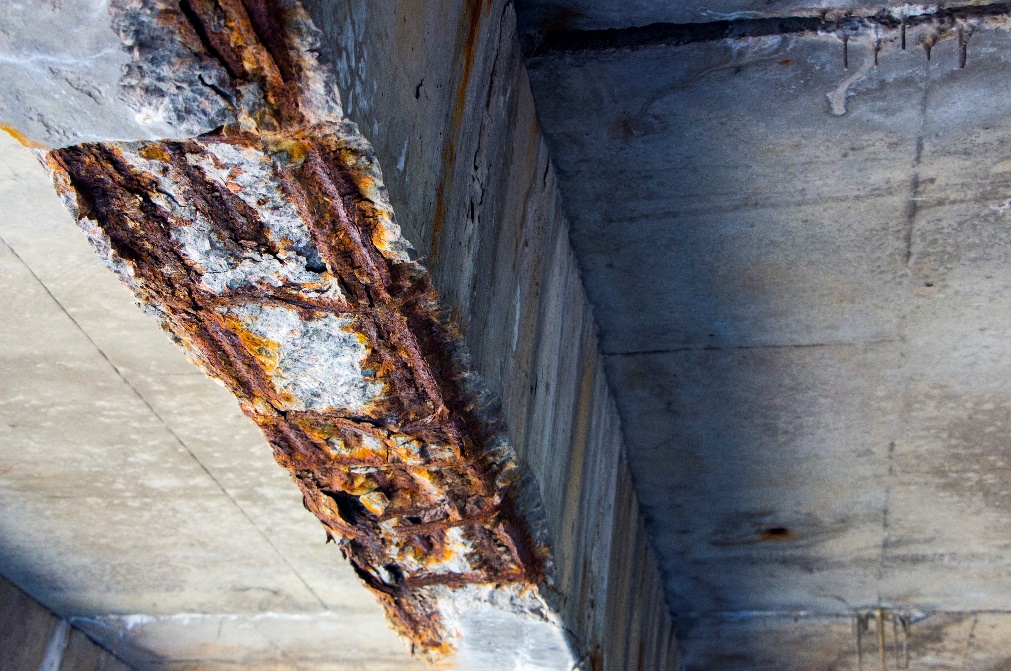Corrosion assessment plays a crucial role in ensuring the long-term durability and structural integrity of concrete infrastructure. Corrosion represents one of the most severe and pervasive durability mechanisms affecting concrete structures. When reinforcement steel corrodes, it leads to expansive forces that result in cracking, spalling, and reduced load-carrying capacity. Timely and accurate corrosion assessment is crucial to identify vulnerable areas, prioritize maintenance efforts, and prevent costly and extensive repairs or replacements.
The corrosion process in concrete structures is primarily influenced by the presence of moisture, oxygen, and the electrochemical interaction between steel reinforcement and the surrounding concrete.
The main reasons for the occurrence of corrosion in concrete structures can be summarized as follows:
- a) Exposure to Moisture and Oxygen: When moisture and oxygen come into contact with the steel reinforcement, an electrochemical cell is formed, initiating the corrosion process.
- b) Presence of Chloride Ions: Chloride ions, whether from marine environments or deicing salts, significantly increase the corrosion rate by breaking down the protective layer on the steel surface.
- c) Carbonation: Carbonation reduces the alkalinity of concrete, compromising the passivation layer and exposing the reinforcement to corrosion.
- d) Poor Construction Practices: Inadequate concrete cover, insufficient quality control during construction, improper placement of reinforcement, or inadequate waterproofing measures can contribute to the occurrence and acceleration of corrosion.
Understanding the mechanisms and reasons for corrosion in concrete structures is crucial for implementing effective preventive measures, such as proper concrete mix design, adequate concrete cover, corrosion inhibitors, and regular maintenance to mitigate the risk of corrosion and preserve the structural integrity of the concrete elements.
Cost of Corrosion Damage
The economic impact of corrosion damage on bridges and concrete structures in the United States is substantial. Statistics reveal that a significant portion of the allocated budget for infrastructure maintenance and repair is spent on addressing corrosion-related issues. The repair costs associated with corrosion damage encompass not only the direct expenses of structural rehabilitation but also the indirect costs arising from disruptions, traffic delays, and potential safety hazards. It was determined that the total direct cost of corrosion in the United States is approximately $276 billion per year, which is 3.1 percent of the nation’s gross domestic product (GDP). In the United States, there are an estimated 583,000 bridges in total. Out of this figure, approximately 200,000 bridges are constructed using steel, 235,000 are made of conventional reinforced concrete, 108,000 are constructed using prestressed concrete, and the remaining bridges are built with other construction materials. It is estimated that around 15% of these bridges suffer from structural deficiencies caused by corrosion of steel and steel reinforcement. The annual direct cost of addressing these issues is estimated to be $8.3 billion. This includes $3.8 billion allocated for replacing deficient bridges over the next 10 years, $2 billion for maintenance and capital costs associated with concrete bridge decks and substructures, and $0.5 billion for maintenance painting of steel bridges[1].

ASTM C876 Half-Cell Potential Method
ASTM C876 provides guidelines for utilizing the half-cell potential method, a non-destructive testing technique, to assess corrosion likelihood in reinforced concrete structures. This method involves measuring the electrochemical potential difference between a reference electrode and a steel reinforcement embedded in concrete. The resulting half-cell potential readings offer valuable insights into the corrosion condition, enabling proactive measures to mitigate the risk. A reference electrode, typically a copper/copper sulfate electrode, is used as a standard against which the electrical potential of the reinforcing steel is measured. The reference electrode is placed on the concrete surface while the potential of the reinforcing steel is measured with a contact probe. The test results are typically recorded as half-cell potentials in millivolts (mV). Positive potentials indicate a lower likelihood of corrosion, while negative potentials suggest a higher probability of active corrosion. The magnitude of the potential can provide insight into the severity of the corrosion process. ASTM C876 is commonly used for evaluating the corrosion potential of reinforced concrete elements such as bridge decks, parking structures, marine structures, and other concrete infrastructure. It helps in identifying areas of concern and prioritizing maintenance or repair activities.
Accu Test’s Corrosion Assessment Service
Accu Test is proud to offer comprehensive corrosion assessment services utilizing the ASTM C876 half-cell potential method. Our team of experienced professionals utilizes state-of-the-art equipment and follows industry best practices to accurately evaluate the corrosion potential of concrete structures. By identifying early signs of corrosion and providing detailed reports, we assist clients in making informed decisions for maintenance, repair, and rehabilitation strategies.
References:
Koch, G. H., Brongers, M. P., Thompson, N. G., Virmani, Y. P., & Payer, J. H. (2002). Corrosion cost and preventive strategies in the United States (No. FHWA-RD-01-156,, R315-01). United States. Federal Highway Administration.




